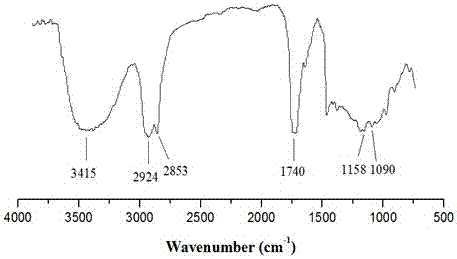Tung oil-based polyol and synthesis method thereof
A synthesis method and polyol technology, applied in the field of polyurethane materials, can solve the problems of high reactivity of epoxy groups, prone to side reactions, poor selectivity, etc., achieve good biodegradability, avoid cross-linking side reactions, and make raw materials available The effect of regeneration
- Summary
- Abstract
- Description
- Claims
- Application Information
AI Technical Summary
Problems solved by technology
Method used
Image
Examples
Embodiment 1
[0025] Add 500g of tung oil and 150g of n-hexanoic acid into a 2000mL three-neck flask, heat up to 40°C and stir evenly. Then slowly add 165g concentration of 30wt% hydrogen peroxide solution, 80g formic acid (85wt% solution), 0.5g concentrated sulfuric acid solution dropwise under vigorous stirring conditions, and then add 160g concentration of 30wt% hydrogen peroxide The solution was slowly dropped into the reaction system, and the rate of addition was controlled to maintain the reaction temperature at about 50°C. After the dropwise addition, the temperature was kept at 50°C for 4 hours, and the reaction ended. After the reaction system was separated into layers, the water phase was removed, and the oil phase was washed with 10 wt% sodium bicarbonate aqueous solution until neutral, and then the product was washed with hot water at 70°C for 3 times. The washed product was distilled at 2000 Pa and 80°C for 2 hours to obtain tung oil-based polyol. After testing, the hydroxyl v...
Embodiment 2
[0027] Add 500g tung oil and 130g n-hexanoic acid into a 2000mL three-neck flask, heat up to 45°C and stir evenly. Then slowly add 165g concentration of 30wt% hydrogen peroxide solution, 60g formic acid (85wt% solution), 4g concentrated sulfuric acid solution dropwise under vigorous stirring conditions, and then add 160g concentration of 30wt% hydrogen peroxide solution Slowly drop it into the reaction system, and control the rate of addition throughout the process to keep the reaction temperature at about 65°C. After the dropwise addition, keep the temperature at 65°C for 3 hours, and the reaction ends. After the reaction system was separated into layers, the water phase was removed, and the oil phase was washed with 10 wt% sodium bicarbonate aqueous solution until neutral, and then the product was washed with hot water at 70°C for 3 times. The washed product was distilled at 2000 Pa and 80°C for 2 hours to obtain tung oil-based polyol. After testing, the hydroxyl value is 1...
Embodiment 3
[0029] Add 500g tung oil and 200g n-hexanoic acid into a 2000mL three-neck flask, heat up to 35°C and stir evenly. Then slowly add 180g concentration of 30wt% hydrogen peroxide solution, 130g formic acid (85wt% solution), 0.25g concentrated sulfuric acid solution dropwise under vigorous stirring conditions, and then add 110g concentration of 30wt% hydrogen peroxide The solution was slowly dropped into the reaction system, and the dropping rate was controlled throughout the process to keep the reaction temperature at about 40°C. After the dropwise addition was completed, the temperature was kept at 40°C for 5 hours, and the reaction ended. After the reaction system was separated into layers, the water phase was removed, and the oil phase was washed with 10 wt% sodium bicarbonate aqueous solution until neutral, and then the product was washed with hot water at 70°C for 3 times. The washed product was distilled at 2000 Pa and 80°C for 2 hours to obtain tung oil-based polyol. Aft...
PUM
| Property | Measurement | Unit |
|---|---|---|
| Hydroxyl value | aaaaa | aaaaa |
| Viscosity | aaaaa | aaaaa |
| Acid value | aaaaa | aaaaa |
Abstract
Description
Claims
Application Information
 Login to View More
Login to View More - R&D Engineer
- R&D Manager
- IP Professional
- Industry Leading Data Capabilities
- Powerful AI technology
- Patent DNA Extraction
Browse by: Latest US Patents, China's latest patents, Technical Efficacy Thesaurus, Application Domain, Technology Topic, Popular Technical Reports.
© 2024 PatSnap. All rights reserved.Legal|Privacy policy|Modern Slavery Act Transparency Statement|Sitemap|About US| Contact US: help@patsnap.com








